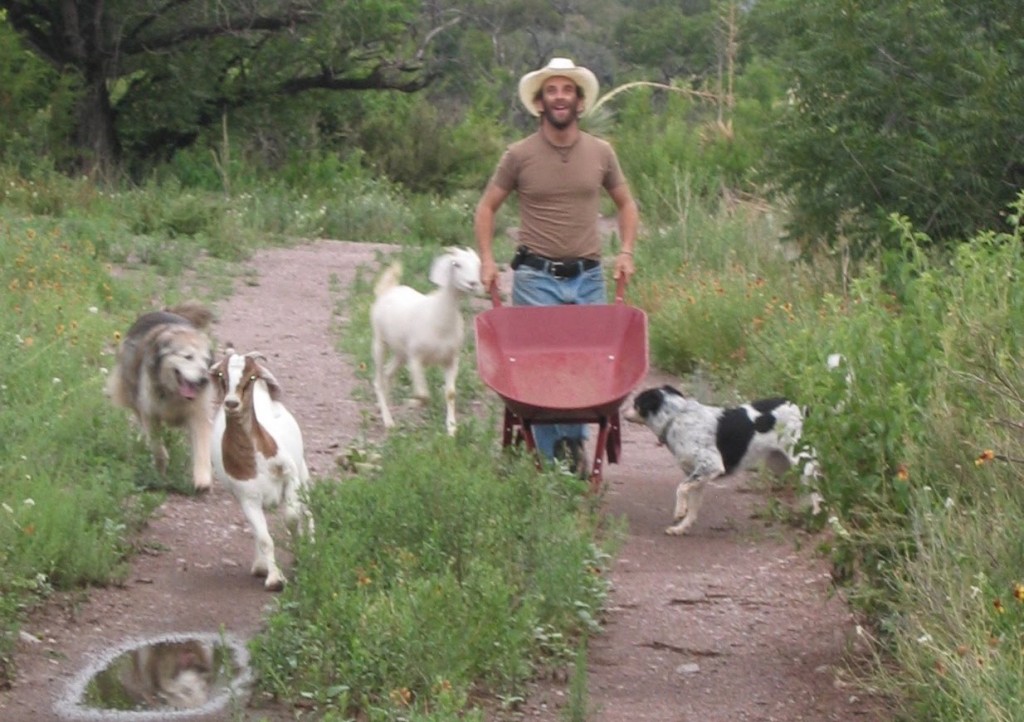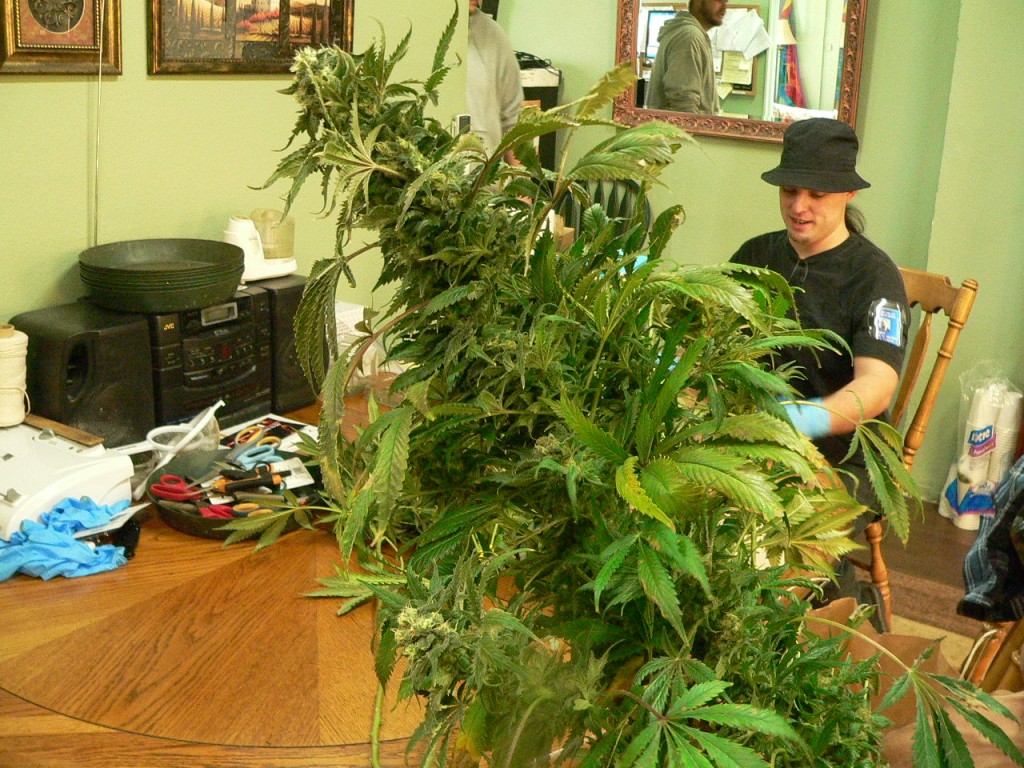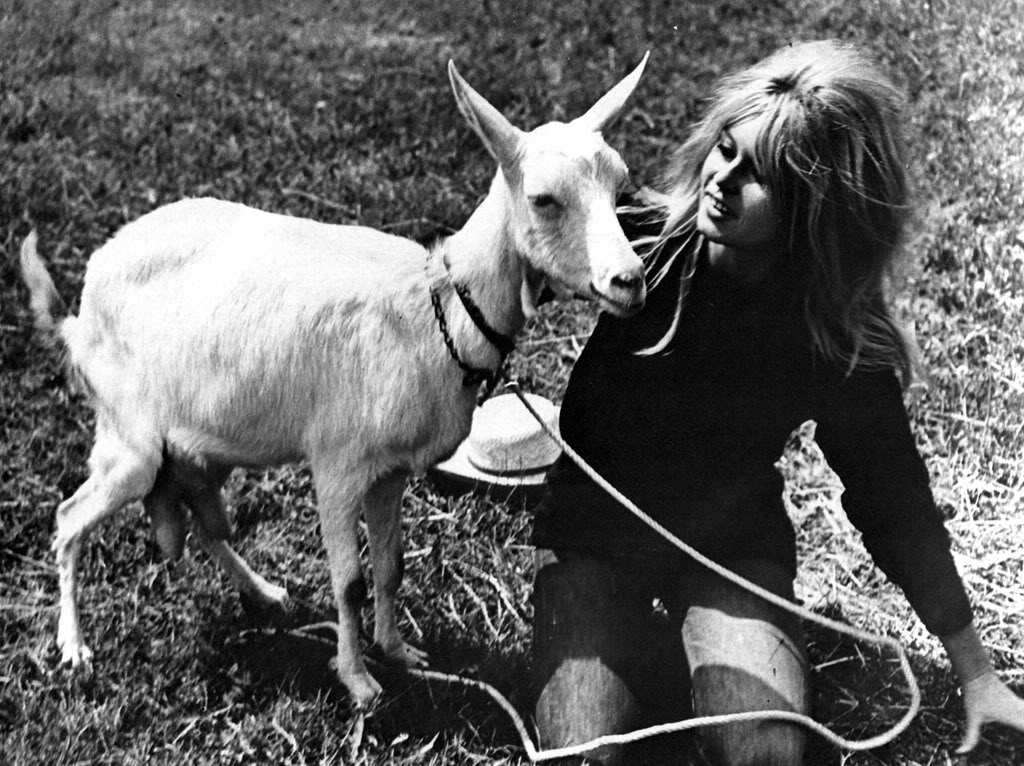
Affable Doug Fine is comfortable around publishers, talk shows hosts, goats, literary agents, Deadheads, dogs, and wheelbarrows.
If you’re after a jammed out, patient-centric, goatherd/Deadhead’s take on cannaculture, Doug Fine’s Too High To Fail is the book for you.
Fine has struck a resonant chord with traditional media, scaling PR heights few pot scribes have attained. For example:
- Not only was his book which claims to be about green economics published, it’s a major release that was purchased by the extremely conservative library closest to me. I’ve previously scoured its shelves for any mention of cannabis commerce and come up empty.
- Fine’s making the rounds of major league talk shows like Conan and The Tonight Show promoting Too High To Fail. The New Mexican author/goatherd instantly connected with Conan’s studio audience, prompting acquaintances from 19 to 92 to weigh in on how much they enjoyed his low-key yet well-informed persona.
- Bill Maher was so impressed that he penned a serious review for The New York Times. My 92-year old dad snail-mailed me the clipping, as is his wont — along with his suggestion to review it for Cannabis Commerce. Wish granted (at the time it sounded like his last request; read on).
In a world hesitant to talk about poteconomics even a little bit, these are rare successes.
Credit to Fine where it’s due — porting marijuana into the mainstream is a tough sell. But sell it he did.
So far so good regarding the publicity jaunt; now we get to the book itself.
I’ll preface the following remarks by conceding it’s unlikely that Too High To Fail’s target demographic includes many readers or critics like me, that is, someone who:
- Spends more time in cannabis hotbeds than Fine
- Writes more extensively about poteconomics than Fine
- Prefers the sound of goats baaing to The Grateful Dead jamming
Click the arrow to hear the sound of goats baaing

Dances with goats: For all we know, this French international film star and/or her dance partner might fall into Too High To Fail’s target demographic.
Then what is the target demographic?
I’ll wager that Too High To Fail is intended more for laymen than full-time poteconomists predisposed to praise cannabis commerce as “the shining star twinkling on the economic horizon.”
But laymen who chance upon Too High To Fail in bookstores or libraries, your basic “voracious readers,” may not make it past an introduction which juggles too many concepts without doing justice to any of them — so it doesn’t draw you in like more finely-honed works. Copious footnotes in tiny type could be a distraction for the stoner set, adding a textbook vibe which could turn-off a crowd which seldom turns to academic treatises for diversion.
Then there’s the matter of Too High To Fail‘s misleading focus. I had a reasonable expectation — based on the book’s tag, “Cannabis and the New Green Economic Revolution” — that economics would be the main course. It isn’t. It’s a side dish, and what there is of it is pretty skimpy. The concentration is on one county, Mendocino, in one state, California — which does not an economic revolution make.
What economic data there is appears to have been fired scattershot throughout the chapters. It jumps out of the bushes when you least expect it. And there’s very little of it that hasn’t been presented before. Author Fine correctly points out that growing marijuana can be economically rewarding; disappointingly, reading Too High To Fail for economic value isn’t rewarding at all.
So, if Too High to Fail isn’t really about green economics, then what is it about? It turns out to be a mock-heroic account of horticulture in a cannabis stronghold: the majority of the book is devoted to recounting a tale of intrepid pot farmers cultivating outdoor crops on a Mendocino mountaintop, in cahoots with an enterprising local sheriff.
If you’re okay with nonfiction that darts in and out of coherence — recalling forty years of Grateful Dead improvisations — and the idea of nurturing outdoor crops in close proximity to The Land of the Giants [redwood forests] strikes you as romantic, you’ll find a cornucopia of information on marijuana cultivation.
The problem with that is the world’s had its choice of books about marijuana cultivation for decades; meanwhile, it’s been starving for great poteconomics reads — and it still is.

Criticizing the band that produced counterculture icons like Pigpen and Captain Trips is like criticizing Jesus, you just can’t win. By the same token, assuming all readers are Deadheads is equally off-putting.
If Too High To Fail isn’t exactly a magnum opus on poteconomics, what about reading it for pleasure? Unfortunately, it’s a halting read at best and as excruciating as three hours of the Dead on bad acid at its worst.
Too High To Fail is just not written well enough, edited well enough, or organized well enough to qualify as a “rollicking good read” and it’s lacking a spark of originality that would mark it as a notable work of nonfiction.
I read it sandwiched in between nonfiction works that are notable works of nonfiction: Michael Pollan’s The Omnivore’s Dilemma and Walter Isaacson’s Jobs [as in Apple founder Steve Jobs]; Too High To Fail suffers in comparison with its more literary competition. Isaacson heads The Aspen Institute, a think tank that “grows leadership initiatives globally;” Fine runs Funky Butte Ranch, which grows goats and organic greens locally — the scent of patchouli practically wafts off his pages. I’ve got nothing against, goats, organic greens, or communal farming (hold the patchouli, please), but just because a meal’s organic doesn’t mean it’s any good.
Too High To Fail’s main plot device owes a debt to The Omnivore’s Dilemma as the inspiration for following a cannabis plant, Lucille, from clone to inhalation — as Pollan followed a bovine, Steer Number 534, from conception to consumption.
The steer’s tale is captivating, the plant’s … not so much.
Too High To Fail’s index lists five separate references to Pollan; Fine has obviously read him extensively — so credit where it’s due would have been in order.
Most of the ground Fine covers has been plowed better elsewhere.
A subplot involving intrepid pot outlaws cooperating with pot-friendly Sheriff Tom has all the makings of a Hollywood movie — whoops, it’s already been made: the excellent NPR Frontline documentary, The Pot Republic — a gorgeously shot piece that lures you in from the opening frame and nails you to your seat throughout. You watch like a fly on the wall as the local constabulary charges the townsfolk by the plant to purchase yellow zip-ties; plants thus marked are ostensibly placed under the sheriff’s protection from intruders including thieves and the DEA — a unique twist permitted under controversial Mendocino County Ordinance 9.31 (which was summarily shot down by federal prosecutors in a decision which surprised no one; it didn’t deter the DEA from filling its quota, either).
From time to time, Too High to Fail detours into describing drug war horrors. If you want to know more about the disturbingly high number of pot “offenders” incarcerated in private, for-profit prisons, that subject was explored more compellingly by Eric Schlosser in Reefer Madness. Schlosser’s Fast Food Nation is also a superior éxpose.
Poteconomists like Jeff Miron and Jon Gettman have been calculating and disclosing the costs of pursuing, prosecuting, and incarcerating pot “offenders” for the better part of a decade. So there’s nothing new about the appearance of these data sets.

OK, so you give a hoot about poteconomics in one county, in one state. What about the rest of the world?
Too High To Fail’s editor doesn’t exactly have Fine’s back. Allowing one instance of a seldom-encountered yet evocative noun like “zeitgeist” indicates intelligence; the second one … maybe less so, cause if you were that intelligent, wouldn’t you notice that an unusual German term appears in consecutive chapters? Three or more? C’mon, already. And all the “My Sweetheart’s” in lieu of Mrs. Fine’s first name stopped me dead in my tracks every time.
I imagine readers are supposed to fall in love with the cast of characters loyal to Mendocino County’s zip-tie program which flew in the face of federal edicts like The Controlled Substances Act. I didn’t, for good reason.
Tomas, the idealized, all-about-the-patients grower, Sheriff Tom, the buck-the-system lawman, and the rest of the cast exhibit a myopic worldview which apparently doesn’t include giving a hoot whether any cannabis commerce takes place outside the 4-wheel drive switchbacks of Mendocino. The collective attitude seems to be, “Just sell me my zip-ties, and I’m good.” That’s not going to ingratiate this crew to more magnanimous folks who envision full legalization for every last person, everywhere on Earth.
All characters parrot the ASA [Americans for Safe Access] patient-centric party line: as long as the sick and dying have “safe access to meds” [medical marijuana], everything’s right with the world. The fact that non-patients remain subjected to fifty different sets of draconian pot laws in the US alone is considered a minor annoyance.
For reasons I find increasingly difficult to fathom, most pro-pot readers — brainwashed that medical marijuana is a progressive concept — swallow that mentality hook, line, and sinker.
Then again, most readers didn’t write Ten Reasons Why Medical Marijuana is Cannabis Commerce’s Ball and Chain or spend three years of their lives analyzing how and why how the patient rights movement [pot for the sick and dying alone] keeps the herbal rights movement [pot for everyman] relegated to The Inquisition.
Casting the magical weed — a plant given by a creator force to all mankind — as a medicine for sick and dying patients alone has the aftereffect of cementing prohibition in place for everyone else.
You may be wondering why I object to ASA & Co. making a “medicine” all about patients. Marijuana is a medicine, isn’t it? And don’t patients need medicine?
Yep, it’s a medicine … and it’s a hundred other things too. Which is why I’ve interrupted this book review to cannalyze what other reviewers have missed:
When special interest groups place the adjective “medical” in front of marijuana, effectively making legalization all about “the patients,” those of us early to realize that MMJ comes with a ball and chain, who don’t appreciate having to bend over and accept one-twentieth the rights we have coming to us, are severely tempted to counter with the specific response that line of thinking elicits: “Fuck the patients!” In moments of weakness, some of us have succumbed to the temptation.
What! Did he just attack patients?
Patients, my foot.
There are real patients and there are make-believe patients. This is as good a time as any to make the distinction.
I have an all-to-fresh image of real patients in mind, having just spent three weeks in HUP [Hospital of the University of Pennsylvania] watching my aforementioned 92-year old dad in diapers, hooked up to IV lines in his hand and lower arm, three PICC lines in his upper arm, a catheter, an oxygen tube, another tube running from his nose to his stomach, plugged into various heart and blood pressure monitors, with doctors, nurses, aides and interns scurrying in and out of his ICU room all day and night giving him shots and pills and carting him off to a succession of soul-draining tests including CAT scans, X-rays, and ultrasounds.
That’s a patient.

I couldn’t help noticing how useless local patient rights initiatives [like the ones in Mendocino] are when my 92-year old dad had no appetite in a pot void like Philadelphia.
Can a put a number value on “the majority?” Yes I can: 75% in Colorado. Fine would have us believe that the number in Mendocino County is 0%.
The implication that all the weed grown by concerned, caring farmers in Mendocino County goes to “patients” for “medical purposes” is not even remotely believable.
People have been invited to feign state-approved illnesses — taking advantage of quasi-legal loopholes to gain “safe access to meds” — because patient rights groups declined to pursue full legalization over the long haul in favor of passing constricted legislation that takes care of a few people’s short term needs today. How much more obvious can that be?
It’s beyond me how an intelligent being like Fine can immerse himself in cannaculture for an entire growing season and not conclude that patient rights is a flawed concept which postpones the repeal of prohibition until some distant Stardate.
That’s why I don’t share Fine’s outrage that the DEA chainsawed MendoGrown crops down during the Northstone raid: that’s precisely what voting for patients-only initiatives empowers enforcement agencies on the local, state, and federal levels to keep on doing until the end of days.
Fine is paid to write. DEA special agents are paid to seize and eradicate. That’s just the way it is. If you’re after real change, seize and eradicate prohibition — don’t go betting the family farm on goofy zip-tie programs.
So excuse me if I’m not up in arms over local problems in Mendocino County, California.
And I don’t want to hear about the State of California’s problems, either.
Why not?
Historically, states which came down on the side of states rights were populated with folks who walked around believing it was their god-given right to own slaves.
Conversely, the notion of individual states allowing human bondage sounded pretty despicable to Abraham Lincoln, for one — who happens to have a monument named after him.
Yet patient rights groups in 2012 are ga-ga over states’ rights. Saying that they’ve learned nothing from the lessons of history is an understatement. This is what happens when a nation grows up on Gone in Sixty Seconds instead of Gone With the Wind.
When states go off on crazy tangents, the feds have to step in and restore sanity.
Or, in this case, sanity needs to be restored on the federal level by defeating prohibition once, not by passing MMJ initiatives on the state level over fifty times. That’s the definition of insanity.
So, Doug, which side of states rights do you come down on, slavery or sanity? Need a little more actual evidence not personal opinion to make up your mind? Fine.
Passing constricted statewide MMJ initiatives instead of repealing federal prohibition has proved to invite the inevitable consequences like:
- DEA smash-and-grab raids like the Northstone raid Fine writes about
- The LA City Council voting all the city’s dispensaries out
- US Attorneys on soapboxes railing about the perils of bongs and pot cotton candy
It also leaves behind a bit of unfinished business — that pesky Controlled Substances Act — that the DEA, US Attorneys, and federal judges are sworn to uphold.
Does anyone except the most zealous bigots believe that women, blacks, and gays should be treated differently in the eyes of the law in various states and localities? Of course not. That would be unthinkable. Then why is it okay to regulate marijuana differently in different states?
The answer is that it’s not okay — despite patient rights groups telling us over and over that it is.
But that’s what most of us are spinning our wheels fighting for as we speak.
This is as good a time as any to turn that thought process around!
Still not sure you want to opt out of state-by-state “legalization?” Let me bring the issue a little closer to home.
Ninety-two-year-old Henry Kohn, who somehow survived being torture-tested for a month by one of the best-equipped hospitals on earth, had zero appetite when HUP’s rotating banks of physicians and physicians-in-training finally called off the dogs. Now that he’s back home, d’ya think the barbaric pot state of New Jersey, which hasn’t dispensed gram one going on year four of its medical marijuana program, is going to help him out with a little something to stimulate his taste buds — so he doesn’t starve himself to death after somehow surviving his ordeal? Why no, it’s not. But if he lived in Colorado, no problem, here’s your meds, dude, knock yourself out. What exactly is okay about that?
Martin Luther King wouldn’t have a day named after him if he only cared about integrating the state of Alabama.
Gandhi wouldn’t be revered if he only liberated the province of Kashmir instead of the entirety of India.
Going state-by-state or province-by-province wasn’t good enough for MLK and Gandhi. History has taught us that if you want to effect paradigm change you change the whole country, not one part of it. But patient rights groups and MMJ advocates insist we should do the exact opposite of what MLK and Gandhi preached. Really?
After reading all that, can anyone still defend legalization state-by-state? Still dreaming that MMJ initiatives represent “getting a foot in the door?” Think again.
Next, what’s all this hogwash about growing pot outdoors in Mendocino being the be-all and end-all of marijuana cultivation?
Just as there are other bands in the world besides the Dead, there are more ways and places to grow marijuana than outdoors in Mendocino, California. Why not celebrate the diversity?
Gushing over the supposed supremacy of California outdoor-grown to any indoor weed grown anywhere by anyone … presupposes that the reader has no basis for comparison. Well, the occasional reader lives in Denver and regularly frequents any number of lush indoor gardens flourishing inside anonymous-from-the-outside commercial warehouses. That’s a pretty good basis for comparison
Perfectly awesome indoor colas [huge, colorful buds] more than satisfy a pot-thirsty Colorado clientele not known for bemoaning the dearth of outdoor buds. No one’s burying unsold indoor buds anywhere in the state. So please spare us the MendoGrown xenophobia, if you would.

This Lakewood, Colorado indoor colossus is Exhibit A that not only Mendocino-grown outdoor weed is blessed by the Big Budmaster In The Sky.
Fine praises outdoor-grown as the only way to go — even as he decries continual helicopter flybys and harps on weather-related challenges like erosion, floods, droughts, bacteria, contaminated soil, and insatiable insects. Um, isn’t it nice to have another option that works fabulously well? Wouldn’t the tremendous strides indoor growers have achieved in Colorado deserve a pat on the back from a book purporting to promote green economics? In an expanding universe, isn’t there room for both fantastic indoor and outdoor growers? Doesn’t that just create more opportunity, or am I missing something?
Finally, in an attempt to accurately depict cannaculture, wouldn’t it be more honest to mention that most growers and trimmers are “medicated” most of the time and act awfully cranky when they’re not? Or note that their conversations are dominated by reminiscing about memorable strains from the past, discussing what they’re going to smoke on their breaks, and wishing for ever more exotic, increasingly potent rarities they can’t wait to try in the future?
I’m supposed to believe that no one on Mendocino grow crews breaks up their 14-hour workday with a toke or ten or forty? You’re kidding, right? Portraying this crowd as teetotallers doesn’t bring them to life, it whitewashes their lives.
Enough. Time to herd those goats back into the pen.
Author Fine has succeeding spectacularly at getting mainstream America to pay at least some attention to crucial cannabis issues — no simple task. My hat is off to him in this respect.
Too High To Fail has some convincing data, albeit it’s presented way too randomly for some tastes.
Fine’s account of growing sensimilla in Mendocino has its moments — if you haven’t heard it or seen it before.
The book’s most poignant moment comes when Fine, sitting in a courtroom, observes youthful “offenders” represented by public defenders receiving their sentences before they’re led away in chains, trudging from the courtroom to the big house.
That image pinpoints Too High To Fail‘s ultimate shortcoming: the last time I checked, not one prisoner, in any state including MMJ states, has been released on ASA’s watch. Intentional or not, fixating on patients instead of people keeps prisoners behind bars. Fine or his editor could have connected the dots. It’s not all that hard.
Lastly, Fine might want to get off the patient rights jag if he wants to be taken seriously as a poteconomist; nothing clamps a headlock on the cannanumbers like the deadly duo of MMJ and patient rights.









1 comment
marla says:
Jan 20, 2015
for someone who didn’t dig this book, you sure had a lot to say